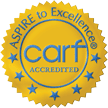Using Yoga to Put Your Mind at Ease
Although there are more than 30 million yoga practitioners in the U.S., many people are uncertain about it, even though the medical community points to its many benefits. One reason why is that many people feel if they’re not flexible enough or don’t look a certain way, they won’t reap those benefits. If concerns like these have stopped you from trying different yoga styles, reframe your approach to it as another form of mindfulness that may improve your mental and emotional wellness.
How Yoga Puts Your Mind at Ease
The combination of physical movement—however minimal—mindful breathing, and a chance for stillness creates a holistic approach to relaxation and mental clarity. More importantly, the deliberate focus on breathing during yoga helps regulate the nervous system, reducing stress and anxiety, while the physical postures release tension from the body. This integrated practice fosters a deep connection between your body and mind, allowing you to quiet racing thoughts, enhance self-awareness, and cultivate a sense of inner peace that extends beyond the yoga mat into daily life.
While performing breathwork outside of a yoga practice can be done at any time, there’s a lot of evidence to suggest that movement, breath, and stillness together have a major impact. For example, one cumulative study review states that for a diverse group of adults, yoga-based interventions:
- Create structural and functional changes in your brain.
- Influence psychological processes involved in the regulation of mood and emotion, including self-compassion, dispositional mindfulness, rumination, meta-cognition, attention, and memory.
- Decrease stress reactivity and influence physiological markers of stress reactivity including changes in blood pressure, heart rate, cortisol, or cytokine levels, resulting in overall improved health and well-being.
Harvard Medical School also highlights the cascading effects of even the most gentle yoga practice. “Yoga develops inner awareness. It focuses your attention on your body’s abilities at the present moment. It helps develop breath and strength of mind and body.” This gives you the power to incorporate other healthy habits such as mindful eating, meditation, exercise, and more.
Different Yoga Styles to Try
The primary point to remember is that yoga is for every body. The Yoga and Body Image Coalition is a nonprofit dedicated to reducing the stigma that only “certain people” should practice. Its vision is “to create a united effort in promoting inclusivity, active transformation, and physical, spiritual, and mental empowerment in the yoga community.” This is a great resource for anyone concerned about whether they belong in a class and how to overcome that.
There are many disciplines of yoga and numerous styles derived from those disciplines. Let’s take a closer look at just a few.
Trauma-Informed Yoga
The Trauma-Informed Care Implementation Resource Center (TICIRC) defines trauma as “exposure to an incident or series of events that are emotionally disturbing or life-threatening with lasting adverse effects on the individual’s functioning and mental, physical, social, emotional, and/or spiritual well-being.” Over the years, chronic stress and trauma decrease the neuronal connections in the brain, making it even more challenging for someone to self-regulate emotions and avoid fear-based memories. Trauma-informed yoga may help.
Specialized yoga programs, featuring a Certified Yoga Therapist (C-IAYT) or a Trauma Center Trauma-Sensitive Yoga Instructor (TCTSY), help individuals create more awareness of and comfort in their bodies. Known in the medical community as a “body-first” approach, this allows someone to let go of buried emotions and layers of stress and tension. A typical yoga sequence in this practice has very few poses so you can breathe and acknowledge any sensations and move through them safely.
Y12
Formerly known as Yoga of 12-Step Recovery, the organization “connects the dots between the somatic approach of yoga and the cognitive approach of recovery models including the 12-Steps, harm reduction, and cognitive behavioral therapy.” They state that, “Our holistic approach is offered within an ecosystem of Y12 programs that invites individuals to build capacity and resilience, to cultivate skillful mind states for skillful actions, to practice presence, to integrate, to learn, to teach, and to heal within the context of community.”
All yoga classes, both in-person and online, are donation-based and led by certified Y12 yoga instructors.
Restorative Yoga
Another way to put your mind at ease during yoga is to hold gentle poses longer, which allows you to focus on your breath and stimulate the vagus nerve for better relaxation. Instructor Judith Lasater is credited for developing restorative yoga based on the classic principles of Iyengar yoga. The University of Chapel Hill School of Medicine indicates that “the primary focus of restorative yoga was to assist in the recovery from illness or injury. It’s reportedly ideal for restoring quality of life to individuals on the way to burnout from stress. The practice of restorative yoga stimulates the parasympathetic nervous system which slows the heart rate, regulates blood pressure, and relaxes the body.”
Many restorative yoga sessions include the use of many props, such as bolsters, pillows, blankets, blocks, and eye masks, to encourage a complete release into a posture—sometimes for as long as five minutes—before slowly transitioning to the next.
Trust in Seabrook’s Holistic Care
Whether you’re interested in yoga and meditation or eager to try other holistic therapies for recovery wellness but haven’t found the right fit, turn to Seabrook’s four award-winning addiction treatment centers in New Jersey. Our board-certified professionals believe evidence-based, individualized treatment includes various techniques to provide you with the most effective approach to wellness. Talk to our admissions team to learn more.




